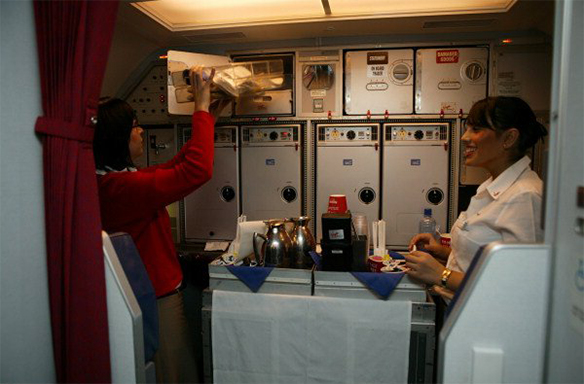Flight attendants are not only friendly with their passengers, they’re also often super friendly with each other. This may be because especially gregarious people go into the profession, but it’s also an adaptation to a surprising structural feature of their job. It turns out that, on any given flight anywhere in the world, most flight attendants are meeting their co-workers for the very first time.
There are about 100,000 flight attendants in the U.S. alone and they get their flights through a process of bidding, one month at a time, one month ahead. Most really do “see the world,” as the old glamorized image of the intrepid stewardess suggests, instead of working the same route over and over again. As a result, explains Drew Whitelegg in Working the Skies, they rarely run into the same flight attendant twice.
This means that flight attendants must get to know one another quickly once they get on board. They need to do so to make food and beverage service efficient, to coordinate their actions in the tight galleys in which they work, and, most importantly, so that they will trust one another if they are called upon to do what they are really there for: acting in an emergency, one that could theoretically happen within seconds of take-off. There’s no time to lose. “[F]rom the moment they board the plane,” writes Whitelegg, “these workers — even if complete strangers — begin constructing bonds.”

Their instant bonding is facilitated by their shared experiences and their “peculiar identity,” Whitelegg explains—few people understand their job and the airline industry deliberately misportays it—and also by a culture of confession. The galley has its own rules to which new flight attendants are socialized. So, even though the workers are always new, the workplace is predictable. Whitlegg describes how galley conversations during downtime tend to be extremely, sometimes excruciatingly personal. ”The things you hear,” laughs Clare, a flight attendant for Continental, “I could write a book. The things you hear at 30,000 feet.” It’s the odd combination of a habit of bonding and the anonymity of strangers.
So, if you have the pleasure of taking a flight, spend a few minutes watching the surprising coordination of strangers who seem like old friends, and take a moment to appreciate the amazing way these workers have adapted to their very peculiar position.
This post originally appeared onSociological Images, a Pacific Standard partner site.



